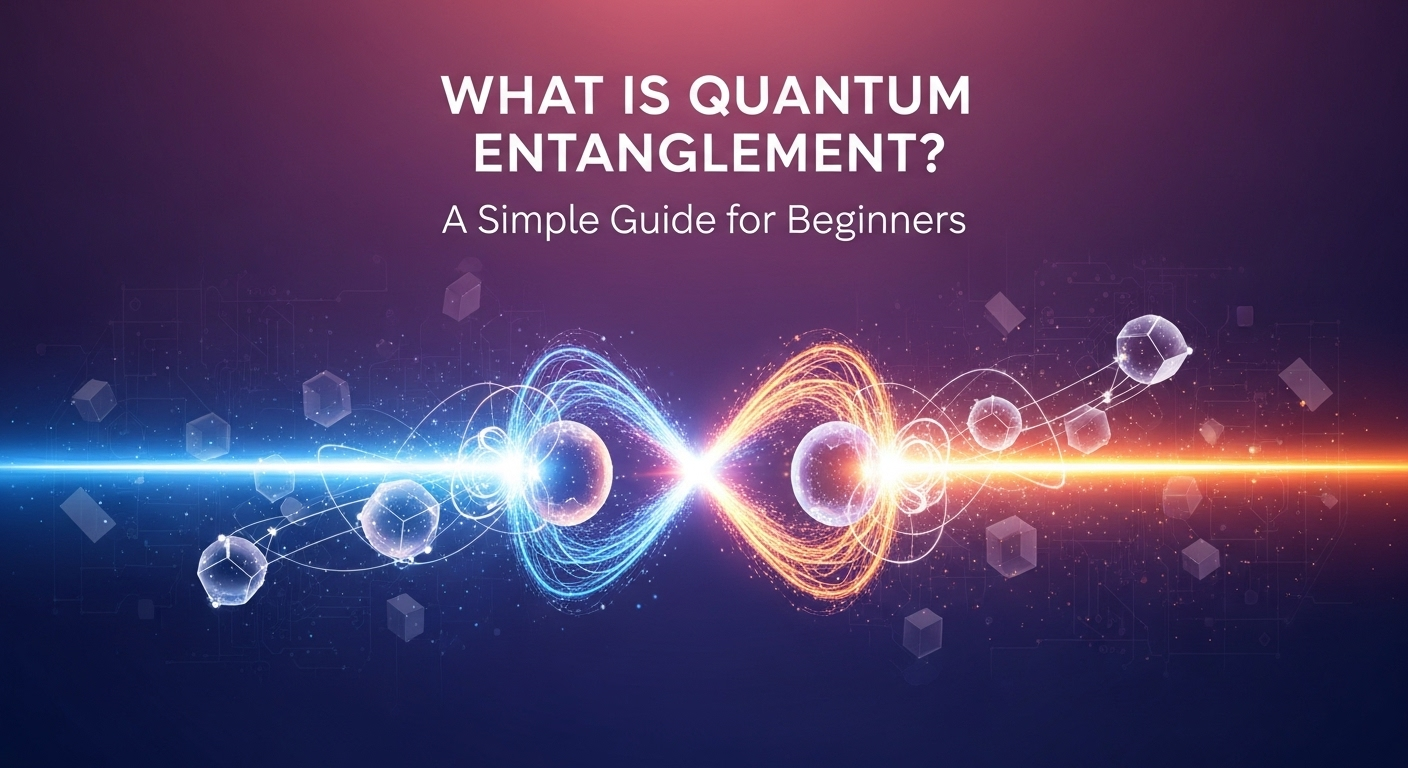Have you ever heard a term that sounds like it was pulled straight from a science fiction movie and wondered what it could possibly mean? Quantum entanglement is one of those concepts. It’s a cornerstone of modern physics that challenges our everyday understanding of reality, a phenomenon so strange that even Albert Einstein called it "spooky action at a distance." But what if you could grasp this mind-bending idea without a Ph.D. in physics? This guide is designed to be your simple, clear roadmap, answering the question of what is quantum entanglement for dummies and for anyone curious about the deepest mysteries of our universe. We will trade complex equations for simple analogies and journey together into the weird and wonderful world of the quantum realm.
Table of Contents
ToggleThe Core Concept: What Is "Spooky Action at a Distance"?
At its heart, quantum entanglement describes a special, intimate connection between two or more quantum particles, like electrons or photons. When these particles become entangled, they form a single, unified system, no matter how far apart they are separated. Think of them as a pair of "cosmic twins." What happens to one twin instantly affects the other, whether they are in the same laboratory or on opposite sides of the galaxy. This instantaneous connection is what baffled early 20th-century physicists, including the great Albert Einstein.
To understand this better, let's use a classic analogy: the magic gloves. Imagine you have a pair of gloves, one right-handed and one left-handed. Without looking, you put each glove into a separate, identical box. You keep one box and give the other to a friend who travels to the Moon. Before you open your box, you have no idea which glove it contains—it could be the right or the left. But the moment you open your box and see you have the right-handed glove, you instantly know, with 100% certainty, that your friend on the Moon has the left-handed one. There was no need to send a message; the information was revealed instantaneously across a vast distance.
Quantum entanglement works in a similar—though fundamentally stranger—way. The properties of the entangled particles, such as their "spin" (a quantum property that's loosely analogous to a tiny magnet pointing up or down), are not determined until one of them is measured. Like the unopened boxes, each particle exists in a state of all possibilities at once (a concept called superposition). But the moment you measure the spin of one particle—for instance, you find it's "spin-up"—its entangled partner, wherever it is, instantly assumes the opposite state, "spin-down." This is the "spooky action" that so troubled Einstein, as it seemed to violate the universal speed limit: the speed of light.
Unraveling the Mystery: How Entanglement Works (Without the Math)
While the glove analogy is helpful, it has one key flaw: the gloves already had a definite state (right or left) before they were boxed up. In the quantum world, this isn't the case. The properties of particles aren't decided until the moment of measurement. This is where the real weirdness of quantum mechanics comes into play, governed by a few key principles.
1. The Principle of Superposition
Before we can fully grasp entanglement, we must first understand superposition. Imagine a spinning coin. While it's in the air, it's neither heads nor tails—it's a blur of both possibilities. Only when it lands and you "measure" it does it collapse into a single, definite state: either heads or tails. Quantum particles behave similarly. Before measurement, a particle can be in a superposition of all its possible states at once. An electron's spin isn't "up" or "down"; it's in a probabilistic combination of both up and down simultaneously.
This isn't just a lack of knowledge on our part; it's the fundamental reality of the particle. Entanglement takes this one step further. When two particles are entangled, their superposition states are linked. If Particle A is in a superposition of "up" and "down," and so is Particle B, their combined system is described by a single state. Measuring Particle A to be "up" doesn't just reveal its state; it forces Particle B to collapse into the "down" state instantly. They were always connected, part of one undetermined, spinning-coin system.
2. Creating Entangled Pairs
So, how do scientists create these cosmically connected pairs? Particles don't just become entangled by chance. The process usually involves creating a particle system and then allowing it to decay or split in a way that respects certain conservation laws. For example, a common method involves shining a laser through a special type of crystal. Occasionally, a single high-energy photon from the laser will spontaneously split into two lower-energy photons.
Because of fundamental physical laws (like the conservation of momentum and energy), the properties of these two new photons must be correlated. If the original system had a total spin of zero, the two new photons must have opposite spins to maintain that zero balance. They are born connected, their fates intertwined from the moment of their creation. This process ensures they become a single entangled system, ready to demonstrate their "spooky" connection across any distance.
3. The Act of Measurement
This is the climax of the quantum story. Scientists separate the entangled pair, sending them in opposite directions. At two different locations, detectors are set up to measure a specific property, like spin. When the scientist at Location A measures their particle, its superposition collapses into a definite state (e.g., spin-up). At that very instant, the particle at Location B, no matter how distant, abandons its own superposition and collapses into the corresponding state (spin-down).
The crucial point here is that the outcome at Location A is completely random. The scientist can't decide to make their particle "spin-up" to send a secret message. They can only observe the random outcome. It's only later, when the two scientists compare their notes (by communicating at or below the speed of light), that they see the perfect anti-correlation in their measurements. Every time A was up, B was down, and vice-versa. The spookiness isn't in sending a message, but in the perfect, instantaneous correlation between two random events separated by space.
Einstein vs. Bohr: The Great Quantum Debate
The bizarre nature of entanglement sparked one of the most famous debates in the history of science, pitting Albert Einstein against the Danish physicist Niels Bohr. Einstein, a titan of physics who gave us the theory of relativity, could not accept the non-local, probabilistic nature of quantum mechanics. He was a firm believer in local realism. This view holds two main ideas:
- Locality: Objects can only be influenced by their immediate surroundings. An event on Mars cannot instantly affect an object on Earth.
- Realism: Objects have definite properties that exist even when we are not observing them. The Moon is still there even when no one is looking at it.
Einstein argued that entanglement wasn't "spooky" at all. He proposed that there must be "hidden variables"—like the pre-determined state of the gloves in our analogy—that decide the particles' properties the moment they are created. In his view, the particles were always "spin-up" and "spin-down"; we just didn't know which was which until we measured them. There was no instantaneous communication, just the revelation of pre-existing information. This was a much more intuitive and classical way of seeing the world.
Niels Bohr, on the other hand, was a key architect of quantum theory and embraced its weirdness. He argued that it was meaningless to talk about a particle's properties before measurement. Reality at the quantum level, he contended, is inherently probabilistic and is only defined when an observation is made. The act of measuring doesn't just reveal a property; it creates it. He believed the entangled pair truly was a single, non-local system, and Einstein's "hidden variables" were unnecessary.
For decades, this was a philosophical debate. But in the 1960s, a physicist named John Stewart Bell devised a mathematical theorem, now known as Bell's Theorem. He proved that if Einstein's hidden variables were real, the correlations between measurements on entangled particles would have a certain limit. However, if quantum mechanics as described by Bohr was correct, that limit would be exceeded. This transformed the debate from philosophy into something that could be experimentally tested. Since the 1970s, countless experiments, known as Bell tests, have been performed with increasing precision. The results are conclusive: every experiment has violated the limit set by Bell's theorem, siding with Niels Bohr and confirming that the quantum world is indeed as spooky and non-local as the theory predicts.
Beyond the Spooky: Real-World Applications of Quantum Entanglement
While entanglement might seem like a bizarre abstract concept, it is a very real phenomenon that is already paving the way for revolutionary technologies. Its unique properties are being harnessed to build devices that were once the stuff of science fiction. The leap from theoretical curiosity to practical application is one of the most exciting frontiers in 21st-century science and engineering.
1. Quantum Computing

Classical computers store information in bits, which can be either a 0 or a 1. Quantum computers use "qubits." Thanks to superposition, a qubit can be a 0, a 1, or both at the same time. When you entangle multiple qubits, their processing power grows exponentially. Two entangled qubits can represent four states at once (00, 01, 10, 11), and three can represent eight. A few hundred entangled qubits could perform more calculations simultaneously than there are atoms in the known universe. This immense parallel processing power could solve problems that are impossible for even the most powerful supercomputers today, from discovering new medicines and materials to optimizing complex financial systems.
2. Quantum Cryptography & Secure Communication
The very property that makes entanglement "spooky" also makes it a perfect tool for secure communication. In quantum cryptography, two parties can share a secret key using entangled photons. If a spy tries to intercept and measure the photons to steal the key, the very act of measurement will disturb the delicate entangled state. This disturbance is immediately detectable by the legitimate users, who can then discard the compromised key and generate a new one. This creates a fundamentally unhackable communication channel, as any eavesdropping is, by the laws of physics, guaranteed to be revealed. This could revolutionize data security for governments, banks, and individuals.
3. Quantum Sensing and Metrology
Entangled particles are incredibly sensitive to their environment. This sensitivity can be used to build hyper-accurate sensors. For example, entangled systems can be used to create atomic clocks that are so precise they would not lose a second over the entire age of the universe. They can also be used in medical imaging to produce higher-resolution images with lower doses of radiation. Geologists could use quantum gravimeters to detect underground tunnels or mineral deposits with unprecedented accuracy. By harnessing the delicate connection between entangled particles, we can measure the world around us more precisely than ever before.
Common Misconceptions and What Entanglement Is NOT
The mind-bending nature of quantum entanglement has led to several persistent misconceptions. Clarifying what entanglement is not is just as important as understanding what it is. The most prominent myth is that it allows for faster-than-light (FTL) communication, which would violate Einstein's theory of special relativity.
This is fundamentally incorrect. While the influence between entangled particles is instantaneous, it cannot be used to transmit information faster than light. Remember, the outcome of measuring the first particle is completely random. You cannot force your particle to be "spin-up" to send a "1" or "spin-down" to send a "0." You simply measure it and get a random result. You only know that your friend's particle will have the opposite result. To confirm this correlation, you and your friend must still communicate through classical channels (like a phone call or email), which are limited by the speed of light. Therefore, no information is actually sent FTL.
Another common misconception is that quantum entanglement is a form of physical teleportation, as seen in shows like Star Trek. While there is a concept called "quantum teleportation," it does not involve dematerializing an object in one place and rematerializing it in another. Instead, it's about "teleporting" the exact quantum state of a particle onto another, distant particle using entanglement. The original particle's state is destroyed in the process, and only the information about its state is transferred. It’s a remarkable feat, but it’s not beaming people across space.
Here is a table to help distinguish the classical view from the quantum reality of entanglement:
| Feature | Classical Intuition (Einstein's "Hidden Variables") | Quantum Entanglement (Bohr's View & Reality) |
|---|---|---|
| Particle State | Definite properties exist before measurement. | Properties are in a superposition (undetermined) until measured. |
| Separation | Two separate objects with pre-determined states. | A single, unified system, no matter the distance. |
| Connection | No connection. Revealing one state just tells you about the other pre-set state. | A non-local connection. Measuring one particle instantly affects the other. |
| Information | Information about the state already exists. | Information is created at the moment of measurement. |
| Communication | No FTL communication. | No FTL communication. Information about the correlation is only known after classical communication. |
FAQ: Your Quantum Questions Answered
Q: Can we see quantum entanglement with our own eyes?
A: No, we cannot directly "see" entanglement. It is a property of the quantum realm, which is far too small for us to observe directly. Instead, scientists infer its existence through the statistical results of countless measurements on entangled particles. We see the effects of entanglement in the perfectly correlated data.
Q: Is quantum entanglement a proven fact or just a theory?
A: It is a proven fact. Decades of rigorous experiments, known as Bell tests, have consistently confirmed the predictions of quantum mechanics and ruled out alternative "hidden variable" theories proposed by Einstein. Entanglement is a cornerstone of modern physics.
Q: What is the maximum distance for entanglement to work?
A: Theoretically, there is no limit. Entangled particles should remain connected even if they are on opposite sides of the universe. Experiments have successfully maintained entanglement over hundreds of kilometers on Earth and even between Earth and orbiting satellites, proving its robustness over vast distances.
Q: Does entanglement mean the universe is not "local"?
A: Yes, that is one of its most profound implications. The fact that entanglement is real strongly suggests that our universe is non-local, meaning that events can be linked in ways that defy our classical intuition of space and separation. It tells us that reality is far more interconnected than it appears.
Q: Why did Einstein call it "spooky action at a distance"?
A: He used this famous phrase (spukhafte Fernwirkung in German) to express his deep discomfort with the idea of one particle instantly influencing another across a great distance. It seemed to violate the principle of locality, a fundamental pillar of his theory of relativity, which he held very dear. To him, it was a "spooky" or ghostly action that couldn't possibly be real.
Conclusion: Embracing the Spooky
Quantum entanglement is more than just a scientific curiosity; it is a fundamental truth about the fabric of our reality. It reveals a universe that is deeply interconnected, mysterious, and far stranger than our everyday senses would have us believe. What began as a "spooky" paradox that troubled the world's greatest minds has blossomed into a proven phenomenon that is fueling a new technological revolution. From unhackable communication to computers of unimaginable power, the legacy of this quantum connection is only just beginning to unfold.
While the concepts of superposition and non-locality may challenge our intuition, they also invite us to look at the world with a renewed sense of wonder. The journey to understand entanglement is a journey to the very edge of human knowledge, reminding us that there are still profound mysteries waiting to be discovered, hidden within the strange and beautiful dance of quantum particles.
***
Summary
The article, "What Is Quantum Entanglement? A Simple Guide for Beginners," serves as an accessible introduction to one of quantum mechanics' most perplexing concepts. It explains that quantum entanglement is a deep connection between two or more particles, causing them to behave as a single system regardless of the distance separating them. Measuring a property of one particle, such as its "spin," instantly influences the property of its entangled partner. This phenomenon, famously dubbed "spooky action at a distance" by a skeptical Albert Einstein, is explained using the analogy of a pair of magic gloves in separate boxes.
The article breaks down the underlying principles, such as superposition (a particle existing in all possible states at once) and the process of measurement that collapses this state. It delves into the historic Einstein-Bohr debate, highlighting Einstein's belief in "local realism" versus Bohr's acceptance of quantum weirdness, a debate ultimately settled in Bohr's favor by Bell's Theorem and subsequent experiments.
Furthermore, the guide moves beyond theory to explore tangible, real-world applications, including the exponential power of quantum computing, the "unhackable" security of quantum cryptography, and the unprecedented precision of quantum sensing. It also debunks common misconceptions, clarifying that entanglement does not allow for faster-than-light communication or the physical teleportation of matter. The article concludes with an FAQ section and a reflection on how entanglement reshapes our understanding of a non-local, interconnected universe, transitioning from a "spooky" paradox to a cornerstone of future technology.














